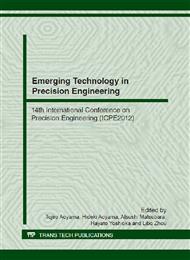p.105
p.109
p.113
p.119
p.125
p.131
p.137
p.143
p.149
Temperature Measurement of Surface Grinding Using a Fluid Supplying System from inside of Grinding Wheel
Abstract:
In this research, the temperature rise of the machined layer during surface grinding using a fluid supplying system from inside of grinding wheel is measured. Compared with the conventional fluid supply from an external nozzle, the grinding fluid is expected to be reached surely to the grinding point if this fluid supplying system is used. Thus the amount of supplying fluid can be reduced keeping the comparable cooling efficiency. Two or more thermocouples are continuously set to the machining layer from its back side through the small hole. Then the temperature change was measured during the continuous reciprocating grinding (round trip) with small depth of cut. As a result, even if the amount of the grinding fluid supply is decreased to 0. 5 L/min, the temperature rise in the machining layer is not very different from the case that the supplying amount is 10 L/min. In addition, by the result of the series of the experiments, the relationship between the temperature rise of the machining layer and the state of the supply of the grinding fluid and the grinding energy is inspected.
Info:
Periodical:
Pages:
125-130
Citation:
Online since:
November 2012
Authors:
Price:
Сopyright:
© 2012 Trans Tech Publications Ltd. All Rights Reserved
Share:
Citation:


